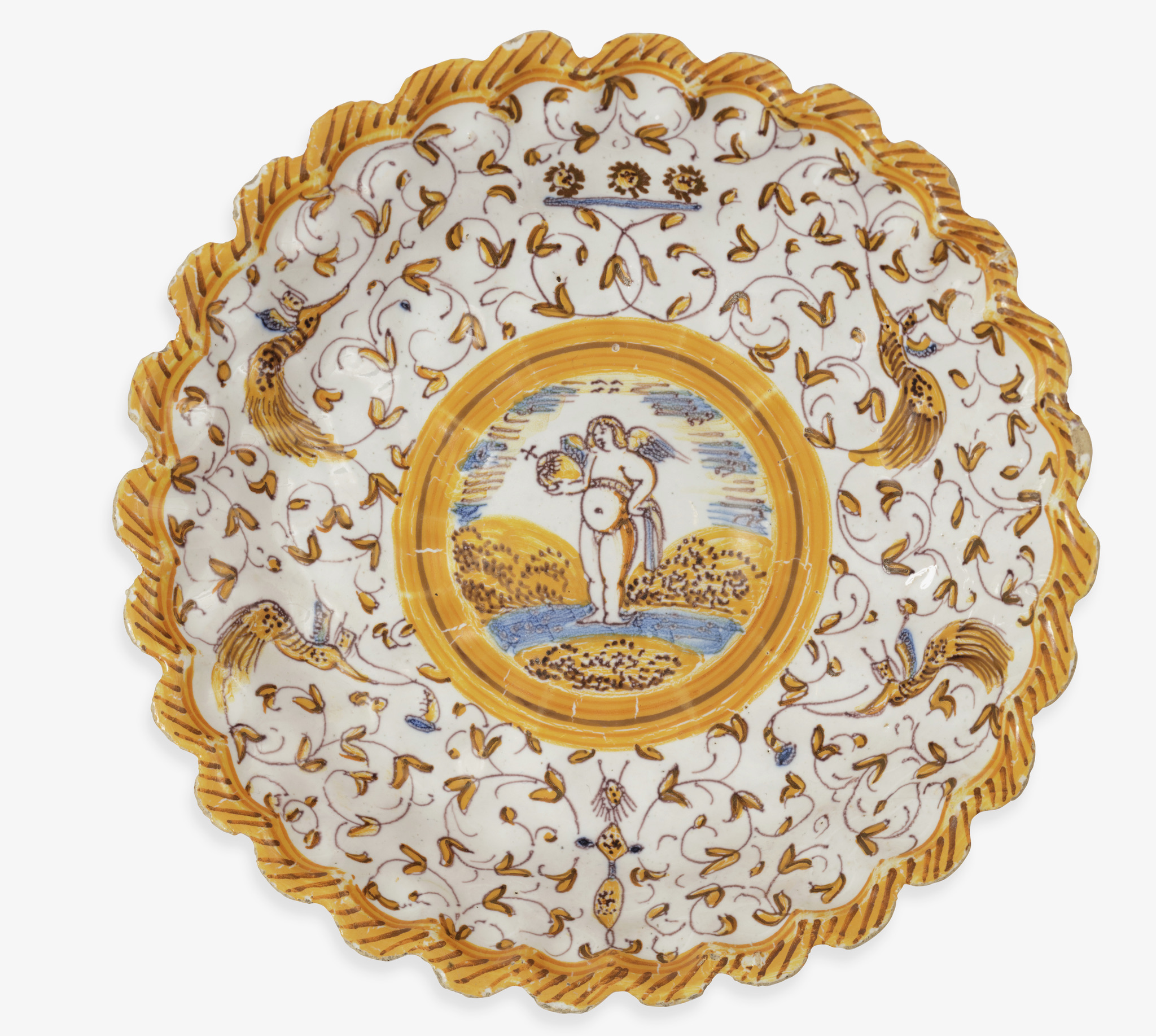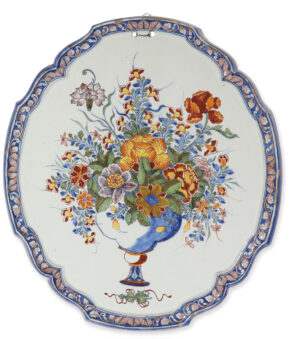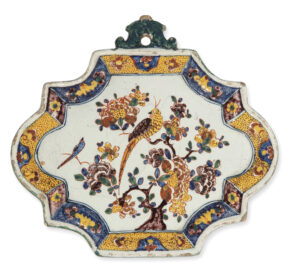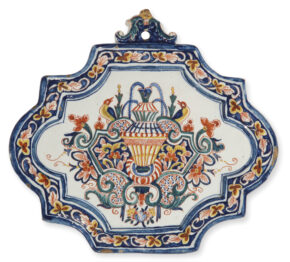![]()
Images on this website are licensed under a
Creative Commons Attribution-NoDerivs 3.0 Unported License.
OBJECT
•D2301. Polychrome Molded Small Dish or Crespina
Haarlem, circa 1650
Attributed to Willem Jansz. Verstraeten, Verstraeten Workshop
The convex center painted in egg-yolk yellow, manganese and blue with a cherub wearing only a sash around his waist, his left hand on his hip and his right supporting an orb, and standing amidst low shrubbery within a yellow roundel delineated with manganese and ochre lines around the fluted cavetto, the rim press- molded with diamonds and circlets and painted with four bird-form grotesques among scrolling floral and foliate vines, all within an ochre-dashed yellow border on the scalloped rim, the reverse tin-glazed.
DIMENSIONS
Diameter: 15.5 cm. (6.1 in.)
NOTE
Traditionally, this type of decoration is known as Grotesques à la Patanazzi, referring to the similar maiolica dishes made by the Patanazzi family of potters in Urbino circa 1515. However, many potters migrated from the Southern European countries to Antwerp, and in the sixteenth century to the northern Netherlands. Around 1600 the city of Haarlem emerged as the leading majolica centre. Multiple inventories show that a total of 45 potters had settled there and the production of majolica increased proportionally. Although it is impossible to identify the work of the 45 potters in Haarlem and to attribute objects to one potter, there is one exception: the wares of Willem Jansz. Verstraeten, who is considered the most important potter in the city of Haarlem during the second quarter of the seventeenth century.
As a son of the Antwerp merchant Jean de la Rue, who later named himself Jan Verstraeten, Willem came to the city of Haarlem in 1590. His father sent him to Delft, where Willem worked as an assistant and later as manager of De Porceleyne Schotel (The Porcelain Dish) factory from 1613 onwards. In January 1625 Verstraeten and the owners of the factory applied for a patent on the pottery-making method. The plan, however, must have changed because the archives show that Verstraeten set up his own pottery in Haarlem in the same year. He bought three houses and received a piece of land from the city council where he established his own pottery. At the time, this was possibly a large and important factory, since there were as many as two kilns and three mills. Furthermore, there were usually 40 to 50 assistants who worked at the factory on a daily basis. That he held a significant position can also be noted from his executive positions in the guild of St. Luke between 1638 and 1651.
Verstraeten mainly produced faience of an exceptional quality until about 1640. He is well known for objects with biblical or historical decorations, which were exceptionally rare in the Northern Netherlands. Many of the dishes made by Verstraeten were inspired by the so-called a compendiario-style of the maiolica from Faenza and Montelupo in Italy. As a reaction to the lavishly decorated Italian maiolica, these objects were given a creamy white, opaque tin glaze. The rim was painted with a sober decoration of egrets and a simple figural image was painted in the center. Verstraeten introduced important technical innovations, which marked the end of the majolica production. From around 1640 his factory created earthenware, which had a layer of white tin-glaze on the reverse. Together with other innovations (such as the blue and white color pattern), the workshop of Verstraeten was able to compete with the sought after Chinese porcelain.
SIMILAR EXAMPLES
A very similar crespina in the Musée National de Céramique, Sèvres (inv. no. MNC 22454) is illustrated in Lahaussois 1998, p. 76, no. 15 where the author comments that this decoration was directly inspired from the ornaments surrounding the paintings of Raphael (1483-1520). Another one with a cherub holding an orb is illustrated in Aronson 2017, p. 9, no. 5. Similar crespinas with the cherub or putto figure at various pursuits within the same or similar decoration on the molded rim, some of which have been attributed to the workshop of Willem Jansz. Verstraeten, are illustrated in Baart 2008, pp. 52, 60, 62, 68, 73, 76- 79 and 84-87, nos. N: 1, 8, 9, 15, 20, 23-26 and 31- 34, who also illustrates on pp. 184 and 185, nos. D 19 and D 20, two very similar crespinas from the Deruta factory in Italy, 1600-50, which may well have been the more direct source for the Dutch versions than the earlier Patanazzi dishes from Urbino.









